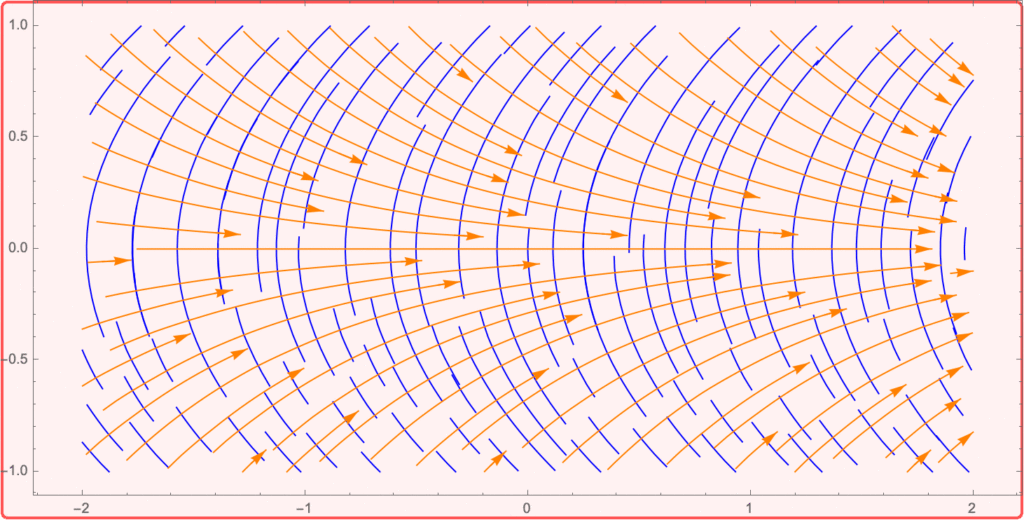Limit Cycles and Isochrones
Consider smooth vector field \(v\) on a manifold with an exponentially stable limit cycle \(\gamma\): in other words, any trajectory starting close enough to \(\gamma\), converges to it exponentially fast. In this situation Guckenheimer proved the existence of isochrons, – a foliation of an open vicinity \(U\supset \gamma\) of the limit cycle by the hypersurfaces intersecting \(\gamma\) transversally, which is preserved by the flow generated by \(v\).
A better way to think of the isochron is to interpret it as a projection \(f:U\to\gamma\) of the basin of attraction \(U\) to \(\gamma\) commuting with the flow. Conceptually (and this is the interpretation suggested by the biologist A. Winfree that motivated Guckenheimer), the periodic clock on \(\gamma\) can be extended from the limit cycle to its vicinity: if once considers \(f\) as the \(\gamma\cong S^1\)-valued function, its evolution under the flow is constant: \[f(\Phi_tx)=S_tf(x),\] where \(\Phi\) is the flow generated by \(v\), and \(S_t\) is the shift (rotation) of the cycle \(\gamma\).

Another way to look at this model is to consider the universal covering \(p:\tilde{U}\to U\) and lift \(f\) to it, obtaining an \(\mathbb{R}\)-valued function \(\tilde{f}:\tilde{U}\to\mathbb{R}\) satisfying \[L_v\tilde{f}=1,\] where we keep the notation \(v\) for the lift of \(v\) from \(U\) to \(\tilde{U}\).
(Yet another way to describe the isochron in this situation, is to focus on the 1-form \(\beta=df\)1, and define the isochrons to be the integral manifolds for the closed \(1\)-form \(\beta\) satisfying \(\langle\beta,v\rangle=1\).)
Isochrons and Martingales
Now, what happens if the dynamics is noisy, or, to be more precise, if the dynamics is given by an stochastic process \(\mathbf{x}(\cdot)\) on the space \(X\), with continuous trajectories? In this case one cannot expect the function \(t\mapsto f\circ\mathbf{x}(t)\) to change with constant rate. At best one can hope for is that to happen on average.
This naturally leads us to the following
Definition 1. A function \(f:X\to\mathbb{R}\) satisfies the martingale condition if \[\label{eq:mart} f(\mathbf{x}(t))-t\] is a martingale with respect to an appropriate filtration of \(\sigma\)-algebras.
(This means, explicitly, that \[\mathbb{E}(f(\mathbf{x}(t))|\mathcal{F}_s)=f(\mathbf{x}(s))+(t-s),\] i.e. that the average rate of growth of \(f(\mathbf{x})\) is \(1\).)
Of course, such a function cannot be continuous and defined globally on a compact space. But it also need not be: it has to be defined only locally. Moreover, when we do that, we have some slack: one needs to know this function only up to an additive constant.
This implies that the correct definition of object we are dealing with is a section of the sheaf \(\mathcal{C}_0\), the factor of the sheaf \(\mathcal{C}\) of continuous functions on \(X\) by the constant sheaf \(\mathbb{R}\).
The sheaf of continuous functions is fine, which implies that in the long exact sequence of Čech cohomologies
\[\label{eq:sheaf} 0\to H^0(X,\mathbb{R})\to H^0(X,\mathcal{C})\to H^0(X,\mathcal{C}_0)\to H^1(X,\mathbb{R})\to H^1(X,\mathcal{C})\to\cdots\]
the second arrow is an isomorphism, the third zero, and the forth an isomorphism again. Indeed, a section of \(\mathcal{C}_0\) defines a singular 1-cocycle the usual way: its restriction to a path define local increments over short open intervals, resulting in a \(1\)-cohomology class.
Using the intuition from the deterministic case, we arrive at the following stochastic analogue of the Guckenheimer’s isochrons:
Definition 2. A stochastic isochron with respect to the process \(\mathbf{x}\), is a section \(f\) of \(\mathcal{C}_0\) satisfying the martingale condition. The image of \(f\) in \(H^1(X)\) is called the winding \([f]\) of the isochron \(f\).
If \(X\) is a manifold, and the functions representing \(f\) are smooth, one can realize the winding class as the closed 1-form \(df\) (defined globally). For some processes, the martingale condition can be expressed in terms of that form.
History
This definition is more or less equivalent to the one introduced by the physicists Pikovsky and Schwabedal in the special case where the underlying phase space \(X\) is a manifold with boundary homotopy equivalent to a circle. They asserted, by analyzing numerically a few examples, that in the case of Langevin dynamics (essentially, diffusion with a drift) the isochrons do exist, and suggested a procedure of constructing them.
This is not an immediately intuitive result, especially in the form Pikovsky and Schwabedal formulated it: there exists a hypersurface intersection with which represent the generator of 1-dimensional cohomology of \(X\), such that starting at the surface, the expected time to hit it again after making exactly one turn is constant on that hypersurface.
Once such a hypersurface is found, it is easy to extend it to a foliation of the manifold by homologous hypersurfaces, essentially resulting in a cocycle the existence of which is stipulated in Definition 2.
The existence of the stochastic isochrons was proved by Lindner and Thomas for a class of diffusions on manifolds. Their proof relies on the rather strict nondegeneracy assumptions, and rather strong tools from elliptic PDEs.
The goal of this note is to present a simple proof of a more general result for quite general random processes on compact topological spaces.
Setup
Let us define more precisely the key components of our construction.
Topology
Let \(X\) be a reasonable compact topological (say, a finite-dimensional triangulable) space. Let \(V=H_1(X)\) be the group of its \(1\)-dimensional singular homologies with real coefficients, and \(L\subset V\) be the lattice generated by the classes represented by loops: the lattice of integer homologies. We will denote by \(r=\mathrm{dim\,}V\) the rank of \(H_1(X)\).
We will be considering various coverings of \(X\) corresponding to the subgroups of the fundamental group of \(X\) (the image the fundamental group of the covering space in \(\pi_1(X)\). If this subgroup is generated by the commutators and torsion elements, one obtains the maximal Abelian covering \(p:\tilde{{X}}\to X\); in other words, the group of deck transformations is the free part \(L\) of \(H_1(X,\mathbb{Z})\). Alternatively, one can think of \(\tilde{{X}}\) as a polyhedron with a free action of \(L=\mathbb{Z}^r\) such that \(L\backslash\tilde{{X}}=X\) is compact.
One can choose a collection of sections of \(\mathcal{C}_0\) generating \(H^1(X)\) under the isomorphism in [eq:sheaf]. If one fixes a basepoint in \(\tilde{{X}}\), these sections would generate a mapping \(h:\tilde{{X}}\to V\) such that the deck transformations correspond to shifts by elements of \(L\subset V\). We will refer to this map (and the corresponding map of \(X\) to \(r\)-torus \(V/L\)) as an Albanese map, after Kotani and Sunada. Note that in their situation of nondegenerate diffusions on manifolds, there is a natural Riemannian metric, and a canonical choice of the harmonic cocycles, making the Albanese map essentially unique. In our setting, it is not.
Stochastics
The dynamics on \(X\) we consider is assumed to be Markov, with a.s. continuous trajectories.
Our key assumption on the process \(\tilde{{X}}\)will be its ergodicity. We will denote by \(\rho\) the invariant measure for the Markov chain \(\mathbf{x}\).
Under these conditions, the process \(\mathbf{x}\) can be lifted to any covering of \(X\), remaining a Markov process with continuous trajectories. We will retain for it the same notation.
Asymptotic behavior of the lift of \(\mathbf{x}\) to \(\tilde{{X}}\), the maximal Abelian covering of \(X\), measures the asymptotic homology (or the winding) of the trajectory.
Lemma 3. If the process \(\mathbf{x}\) on \(X\) is ergodic, then there exists an average winding speed, \[m:=\lim_{T\to\infty}\frac{h(\mathbf{x}(T))-h(\mathbf{x}(0))}{T}\in V\] (here \(h\) is the Albanese map, and, \(\mathbf{x}\) is denoting the lift to \(\tilde{{X}}\)).
We will assume from now on that \(m\neq 0\), and interpret it as the asymptotic winding rate of the process \(\mathbf{x}\).
Main Result
Let \(\beta\in H^1(X,\mathbb{R})\cong V^*\) be a class such that \((\beta, m)\neq 0\). Our main result is
Theorem 4. Under some technical assumptions on \(\mathbf{x}\), there exists an isochron \(f_\beta\) with the winding class proportional to \(\beta\).
As the isochron \(f\) can be lifted to a function \(g\) in the maximal Abelian covering \(\tilde{{X}}\), the martingale condition implies that asymptotically, \(g(\mathbf{x}(T))-g(\mathbf{x}(0))\approx T\), but \((\beta, h(\mathbf{x}(T))-h(\mathbf{x}(0)))\approx (\beta, m)T\). This implies that for the \(\beta\)-isochron \(f_\beta\), its winding is given by \[[f_\beta]=\frac{\beta}{(\beta,m)}.\]
One can complement the existence result with the uniqueness one:
Proposition 7. For ergodic \(\mathbf{x}\), two isochrons \(f,f’\) with the same windings \([f]=[f’]\) are equal.
Proof. Indeed, the difference \(f-f’\) could then be lifted to a continuous function \(g\) on \(X\), such that \(g(\mathbf{x})\) is a martingale. This martingale is bounded, thus converging; the ergodicity of \(\mathbf{x}\) implies that \(g\) is constant. ◻
These existence and uniqueness of the isochrons for the diffusions with drift are resembling the existence and uniqueness of the harmonic forms associated with the full rank (driftless) diffusions on manifolds, but are, of course, of a very different nature.
What Next
One intriguing question that this result presents is how to generalize it to non-compact spaces \(X\)? Indeed, some of the key examples in the works by physicists dealt with the windings of (drifted) diffusions on the punctured planar domain.
The complication here is that the windings around a puncture of a full rank diffusion, while well-defined (a trajectory hits the puncture with probability zero) does not have a mean: one can easily see that its distribution has Cauchy-like tails, just like the standard Spitzer’s winding number.
Yet, the simulations in suggest that a well-defined isochron exists. Of course, they regularize the problem (their puncture is actually a small hole), but how the answer depends on the regularization? This is an interesting question to look at.
- To be pedantic, this form takes values in \(T\gamma\), but by parameterizing \(\gamma\) in such a way that \(v\) restricted to it is the constant (say, \(1\)), we can identify all the tangent spaces with \(\mathbb{R}\)↩︎
